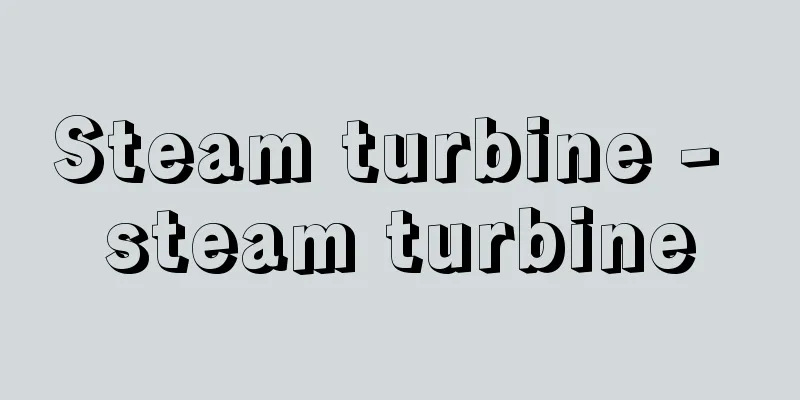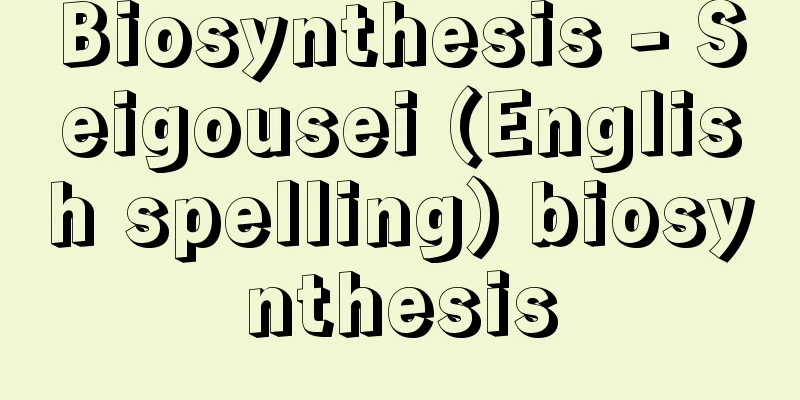Steam turbine - steam turbine

|
A prime mover that converts the thermal energy of high-pressure steam into velocity energy, such as the rotation of an impeller, in other words, mechanical work. High-temperature, high-pressure steam generated in a boiler is ejected from a nozzle or fixed blades, expanded, and hits the impeller, or the steam flow is further accelerated inside the impeller, and the reaction force rotates the impeller. In principle, it is the same as a gas turbine. [Masatake Yoshida] historyIn 55 BC, Heron of Alexandria invented a device in which steam was pumped into a ball with two nozzles facing in opposite directions, causing the ball to rotate due to the reaction of the steam blowing out. This was the reaction turbine, and is said to be the beginning of turbines. The first turbine that actually moved a machine was made in 1629 by Giovanni Branca (1571-1645) of Italy. It had blades attached to the circumference of a horizontally rotating disk, which was rotated by blowing steam through a narrow nozzle and used to crush ore. This was the beginning of the impulse turbine. It was difficult to make a practical and efficient turbine, but several attempts were made. For example, in 1815, Richard Trevithick of England, who created the high-pressure steam engine, created a reaction turbine based on the same principle as Heron's. In 1846, James Jamieson Codes and Edward Locke of England created a 32 horsepower turbine using the same principle as the Blanka, and later used a 150 horsepower turbine as a ship's prime mover. In the meantime, water-powered turbines, which do not flow as fast as steam, made great strides, and modern highly efficient turbines were created. Using these as a reference, full-scale highly efficient steam turbines were developed. In 1888, Carl Gustav Patrick de Laval of Sweden completed a nozzle that converts the energy of high-temperature, high-pressure steam almost completely into velocity energy. This nozzle is a convergent-divergent nozzle whose cross section first becomes gradually narrower and then wider, called the Laval nozzle, and the steam flow velocity at the exit is over 1,000 meters per second. Several of these nozzles are placed around a rotating impeller with symmetrical blades, and the high-speed steam flow is sprayed onto it, converting most of the velocity energy into rotational force for the rotating impeller through impact force. This impulse turbine can expand even very high-pressure steam in a single stage, so the steam flow velocity at the nozzle exit is high, and the efficiency is highest when the peripheral speed of the rotating impeller is about half the steam flow velocity at the nozzle exit, so the impeller rotates at an extremely high speed, reaching over 40,000 revolutions per minute. Therefore, vibration and centrifugal force were problems, but de Laval made the shaft thin so that it would vibrate at low speeds but not at high speeds, and made the cross section of the impeller thickest at the shaft and thinner toward the tip. By 1897, de Laval had invented a reducer using helical gears, which he also used to drive generators. However, de Laval's turbines had a large centrifugal force due to the high speed of rotation, limiting the outer diameter, and it was not possible to create a turbine with high output. In 1895, Charles Gordon Curtis of the United States improved the de Laval turbine, creating a turbine with one nozzle stage but multiple rotating impellers, which divided the velocity energy into each row and converted it into rotational force. This improvement slowed down the peripheral speed of the rotating impeller and reduced the number of revolutions, allowing it to be made larger, and turbines with relatively high output could be made. Usually, one nozzle stage is paired with two rows of rotating blades, and by combining multiple sets of these, it reached over 40,000 horsepower around 1920. In 1897, Auguste Rateau of France and in 1903, YH Zoelly (1862-1937) of Switzerland combined multiple de Laval types to create turbines that divided the expansion of steam into multiple stages. These turbines also had low rotation speeds and produced large amounts of power. In 1884, Charles Algernon Parsons of England created a turbine based on a different principle from de Laval's. Parsons' turbine expands steam with both fixed and rotating blades, and the impact force of the high-speed steam flow leaving the fixed blades and the reaction force caused by the steam expanding inside the rotating blades rotate the rotating impeller, with the fixed and rotating blades arranged alternately. Parsons' turbine has a ring-shaped steam passage in the axial direction between the fixed and rotating blades, and is called an axial flow type. This turbine is suitable for large output because it has a wide steam passage and a low rotation speed. In Parsons' design, the blades are fitted into grooves without being fixed to the rotating impeller or partition plate, and the outer tube (casing) is gradually thickened as the steam expands, and the diameter of the rotating impeller is also increased, so that the steam flow speed is not too high. Parsons lost his patent for the axial turbine for a time in 1889, and built a radial turbine, in which steam passes between fixed and rotating blades placed concentrically, for use on ships, but the high rotational speed made it ineffective. In 1896, he obtained the patent for the axial turbine again, and built the high-speed ship Turbina, equipped with three axial turbines, which recorded a speed of 34 knots per hour. After this, steam turbines began to be used on high-speed ships, and passenger ships appeared that were equipped with four turbines, each with over 20,000 horsepower. In areas where hydroelectric power was not available, steam turbines of over 40,000 horsepower, first Curtis type and then Parsons type, were used to generate electricity. In 1911, the Swedish Ljungström brothers, Birger Ljungström (1872-1948) and Fredrik Ljungström (1875-1964), created a steam turbine that has no fixed blades, but instead uses counter-rotating rotors, with steam expanding radially between them, generating torque from the reaction force. This requires two generators because the two shafts rotate in opposite directions, but the overall size is small, so it is used for medium-sized output. Steam turbines have remained essentially unchanged since then, and are still used today to generate electricity in thermal and nuclear power plants, and as high-output prime movers for large passenger ships and high-speed boats. [Masatake Yoshida] structureSteam is expanded through nozzles or fixed blades to create a high-speed steam flow, which in the impulse type hits the rotor blades and rotates them with the impact force, while in the reaction type, the steam is expanded and accelerated within the rotor blades as well, and is rotated by the reaction and the impact force of the high-speed air flow to obtain mechanical work. Each set of fixed and rotating blades is called a stage. A steam turbine is made up of many such stages lined up. High pressure steam from the boiler enters the steam chamber through a throttle valve, which is adjusted by a stop valve and a governor, and expands through many stages before reaching the exhaust chamber. The area of the steam passage increases as the volume of steam increases due to expansion. The rotating part consists of the turbine shaft, impeller (also called impeller), and rotating blades (also called moving blades). The rotating blades are attached to the tip of the impeller, and in the type that uses reaction, there is a pressure difference between the front and rear of the rotating blades, so airtight fins are used to prevent leakage between the rotor and the casing. The casing is the outer part where the turbine enters, and fixed blades (stationary blades) or nozzles are attached. The fixed blades are attached to partitions that prevent steam leakage between the stages, and the partitions and impellers are placed alternately. Where the turbine shaft passes through the casing, bearings support the shaft and labyrinth packing is installed to prevent steam leakage and air leakage. The turbine shaft not only produces power, but also drives the governor and pumps for lubricating oil, etc. In addition, in the type that utilizes reaction, an axial force acts on the impeller, so a disk (balancing piston) is attached to generate a force that balances this. [Masatake Yoshida] formatSteam turbines are classified into various categories. [Masatake Yoshida] Classification by operation method
(2) Reaction turbines: There are axial and radial flow types, and they also utilize the reaction caused by expansion inside the rotor blades. In axial flow, fixed and rotating blades are arranged alternately to create a circular steam passage. Usually, the fixed and rotating blades have the same cross section. They are also called Parsons turbines. In radial flow, the rotor blades and fixed blades or the rotor blades are arranged concentrically, and steam is let in from the center, expanded, and expelled; the well-known type is the Jungström turbine, which uses two rotor blades that rotate in opposite directions. Examples of turbines with one fixed blade include Siemens turbines. Radial flow turbines are small and are used for medium output. (3) Mixed turbine: A combination of a reaction turbine and an impulse turbine. An impulse turbine such as a Curtis is used in the high-pressure stage with a small steam volume, followed by a reaction turbine. It is widely used as a high-output turbine. [Masatake Yoshida] Classification by steam condition at entrance/exit
(2) Back pressure turbine: The exhaust pressure is set to above atmospheric pressure, and all of the exhaust is used as a heat source for factories, etc. The amount of steam needs to be adjusted by adding factors other than output, and the efficiency of the turbine is slightly lower, but the thermal efficiency of the entire factory is high. (3) Extraction turbine: A portion of the steam is extracted when the pressure exceeds atmospheric pressure during expansion and used for heating, etc. The remainder, which has passed through all the turbine stages, is sent to the condenser. It can freely adjust the amount of steam while maintaining a certain degree of turbine efficiency, and is intermediate between a condensing turbine and a back pressure turbine. (4) Mixed-pressure turbine: A turbine that increases the amount of steam by supplying exhaust gas from a steam engine, etc., to the middle of a normal turbine. (5) Exhaust turbine: Uses only the exhaust gas from a steam engine, etc. Together with the mixed pressure turbine, it can increase the efficiency of an entire facility such as a factory. In recent years, turbines that use steam other than water vapor, such as freon, have been developed for the purpose of utilizing the thermal energy of the exhaust gas from internal combustion engines, but their structure is the same as that of a normal steam turbine. However, when people generally refer to steam turbines, they are referring to turbines that use water vapor. [Masatake Yoshida] Features and ApplicationsSteam turbines can generate large amounts of power by sending large amounts of steam, and the weight per unit of power output decreases as the rotation speed increases. They can also operate continuously for long periods of time and have high thermal efficiency, so they are widely used as high-power prime movers in thermal power plants, ships, factories, etc. Among them, high-power steam turbines are used for power generation, with some even reaching up to 1 million kilowatts. In addition, for combined systems that generate power using a gas turbine to purify exhaust gas and increase efficiency, turbines of around 350,000 kilowatts are used. For ships, the difference in output with diesel engines has become smaller, but high-speed passenger ships use turbines of around 50,000 kilowatts due to their quiet operation. For factories, they are used in a wide range of fields, such as generating steam and heat for work in addition to generating private power. [Masatake Yoshida] "John Robert DayEngines; The Search for Power(1980, The Hamlyn Publishing Group Ltd.)" [References] | | | | | |©Takashi Aoki History of the Steam Turbine ©Makoto Takahashi Steam turbine structure (condensing turbine) ©Makoto Takahashi Classification of steam turbines by operating method Source: Shogakukan Encyclopedia Nipponica About Encyclopedia Nipponica Information | Legend |
|
高圧蒸気のもつ熱エネルギーを羽根車の回転という速度エネルギー、つまり機械的仕事に変換する原動機関。ボイラーで発生した高温・高圧の蒸気をノズルまたは固定羽根から噴出、膨張させて羽根車に当て、または羽根車の中でさらに蒸気流を加速して、その反動によって羽根車を回転させる。原理的にはガスタービンと同じである。 [吉田正武] 歴史紀元前55年にアレキサンドリアのヘロンが、蒸気の送り込まれている球に互いに反対方向を向いた吹き出し口をつけ、蒸気の吹き出す反動で球が回転する装置を考案した。これは反動タービンでタービンの始まりといわれている。実際に機械を動かしたタービンは、1629年イタリアのブランカGiovanni Branca(1571―1645)がつくった機械で、水平に回転する円板の周りに羽根をつけ、それに細い口から蒸気を吹き付けて回転させ、鉱石を砕くのに使用された。これは衝動タービンの始まりである。効率のよい実用的なタービンはなかなかできなかったが、いくつかの試みがなされた。たとえば1815年に、高圧蒸気機関をつくったイギリスのリチャード・トレビシックはヘロンと同じ原理の反動タービンをつくった。また1846年にはイギリスのジェームス・ジャミーソン・コーデJames Jamieson Codesとエドワード・ロックEdward Lockeは、ブランカと同じ原理の32馬力のタービンをつくり、のちに150馬力のタービンを船の原動機として用いた。その間に、蒸気ほど高速流にならない水力利用のタービンが大発展をし、近代的な高効率タービンがつくられた。これらを参考にして本格的な高効率蒸気タービンが開発された。 1888年スウェーデンのカール・グスタフ・パトリック・ド・ラバルは、高温高圧蒸気のエネルギーをほぼ完全に速度エネルギーに変換するノズルを完成した。このノズルは初め断面がしだいに細くなり、次に太くなる先細(さきぼそ)末広ノズルで、ラバルノズルといわれ、出口の蒸気流速は毎秒1000メートル以上となる。このノズルを数個、対称形の羽根をつけた回転羽根車の周りに置き、高速蒸気流を吹き付け、速度エネルギーの大部分を衝撃力で回転羽根車の回転力に変換する。この衝動タービンはかなりの高圧蒸気でも1段で膨張させることができるのでノズル出口の蒸気流速は高く、また回転羽根車の周速がノズル出口の蒸気流速の約半分のとき、もっとも効率が高くなるので、羽根車はきわめて高速で回転し、回転数は毎分4万回以上になる。したがって振動と遠心力が問題であったが、ド・ラバルは軸を細くして、低速で振動しても高速回転では振動がないようにくふうし、さらに羽根車の断面は軸のところでもっとも厚く、先端に向かって薄くつくった。1897年までには、ド・ラバルはヘリカル歯車を使った減速機を考案し、発電機の駆動にも用いた。しかし、ド・ラバルのタービンは高速回転のために遠心力が大きく外径を制限され、大出力のものはつくれなかった。1895年にアメリカのチャールズ・ゴードン・カーティスはド・ラバルタービンを改良し、ノズルは1段であるが回転羽根車を多数にし、速度エネルギーを各列ごとに分割して回転力に変換するタービンをつくった。この改良で回転羽根車の周速は遅くなり、回転数は低くなったので大型化でき、出力の比較的大きいタービンもつくられるようになった。通常はノズル1段に回転羽根2列を1組にし、この組を多数組み合わせて、1920年ごろには4万馬力以上に達した。また1897年にフランスのオーガスト・ラトーが、1903年にはスイスのツェリーY. H. Zoelly(1862―1937)が、ド・ラバル型を多数組み合わせて、蒸気の膨張を何段にも分割するタービンをつくった。これも回転数は低く、大出力のタービンがつくられた。 1884年にイギリスのチャールズ・アルジャーノン・パーソンズは、ド・ラバルとは別の原理のタービンを製作した。パーソンズのタービンは固定羽根と回転羽根の両方で蒸気を膨張させ、固定羽根を出た高速蒸気流の衝撃力と、回転羽根内で蒸気が膨張するときの反動で回転羽根車を回転させるもので、固定羽根と回転羽根が交互に置かれる。パーソンズのタービンは固定羽根と回転羽根が軸方向に環状の蒸気通路をつくり、軸流型といわれる。このタービンは蒸気通路が広く、回転数も低いため、大出力に向いている。パーソンズの設計では、羽根は回転羽根車や仕切り板に固定されずに溝にはめ込まれており、外側の筒(車室)は蒸気が膨張するにつれ段階的に太くし、回転羽根車の径も大きくし、蒸気の流速があまり高くならないように考えられている。1889年からパーソンズは一時、軸流タービンの特許を失い、蒸気が同心に置かれた固定羽根と回転羽根の間を通る半径流タービンをつくって船に使用したが、回転数が高く有効ではなかった。1896年になってふたたび軸流の特許をとり、3基の軸流タービンを積んだ高速船タービナ号を建造し、時速34ノットを記録した。こののち高速の船には蒸気タービンが使用されるようになり、1基で2万馬力以上のタービンを4基積む客船も現れた。また水力の利用できない地方では発電用として、初めにはカーティス型が、その後はパーソンズ型をつないだ4万馬力以上の蒸気タービンが使用されている。 1911年にスウェーデンのユングストレーム兄弟Birger Ljungström(1872―1948)& Fredrik Ljungström(1875―1964)は、固定羽根がなく互いに逆回転する回転羽根の間を半径方向に蒸気が膨張しながら通り、その反動で回転力を得る蒸気タービンをつくった。これは二つの軸が逆回転するので二つの発電機が必要であるが、全体が小型になるため、中程度の出力用として使用されている。 蒸気タービンはその後基本的には変化なく、現在も火力、原子力発電所の発電用や、大型客船や高速船の大出力の原動機として使用されている。 [吉田正武] 構造蒸気をノズルまたは固定羽根を通して膨張させて高速の蒸気流にし、これを衝動型では回転羽根に当てて衝撃力で回転させるが、反動型では回転羽根内でも蒸気を膨張させて加速し、その反動と高速気流の衝撃力によって回転させて機械的仕事を得る。この固定羽根と回転羽根の1組を段という。蒸気タービンはこの段を多数並べて構成される。 ボイラーからの高圧蒸気は、止め弁、調速機などで調節される絞り弁を通って蒸気室に入り、多数の段を通って膨張しながら排気室に達する。蒸気通路面積は、膨張によって蒸気の体積が増加するのに伴い大きくなっている。回転部分はタービン軸と羽根車(翼車(よくしゃ)ともいう)と回転羽根(動翼(どうよく)ともいう)からなる。回転羽根は羽根車の先端につけられ、反動を利用する形式では回転羽根の前後に圧力差があるので、車室との間を気密フィンで漏れ止めをする。車室はタービンの入る外側の部分で、固定羽根(静翼(せいよく))またはノズルを取り付ける。固定羽根は段の間の蒸気の漏れを止める仕切り板につけられ、仕切り板と羽根車は交互に置かれる。タービン軸が車室を通るところでは、軸受が軸を支えるとともに、蒸気の漏洩(ろうえい)や空気の漏入を止めるためにラビリンスパッキンなどがつけられている。なお、タービン軸からは出力を取り出すだけでなく、調速機や潤滑油などのポンプの駆動も行う。また反動を利用する形式では羽根車に軸方向の力が働くので、これとつり合う力を生じるような円板(つり合いピストン)を取り付ける。 [吉田正武] 形式蒸気タービンはいろいろな分類が行われる。 [吉田正武] 作動方式による分類
(2)反動タービン 軸流と半径流があり、回転羽根内での膨張による反動も利用する。軸流は、交互に設けられる固定羽根と回転羽根で環状の蒸気通路をつくる。通常は固定羽根と回転羽根は同一断面である。パーソンズタービンともいわれる。半径流は、同心円状に回転羽根と固定羽根あるいは回転羽根を並べ、蒸気を中心から入れ膨張させて外に出すもので、二つの回転羽根を用い互いに逆回転させるユングストレームタービンが有名である。一方が固定翼のものにはジーメンス社のタービンなどがある。半径流は小型で中出力用として用いられている。 (3)混式タービン 反動タービンと衝動タービンを組み合わせたもので、蒸気体積の小さい高圧段にカーティスなどの衝動タービンを用い、その後を反動タービンとし、大出力タービンとして広く使用されている。 [吉田正武] 出入口の蒸気の状態による分類
(2)背圧タービン 排気圧力を大気圧以上とし、全排気を工場などの熱源として利用する。蒸気量の調節は出力以外の要素を加えて行うことが必要で、タービンの効率としてはすこし低くなるが、工場全体の熱効率は高い。 (3)抽気タービン 膨張途中の大気圧以上のところで蒸気の一部を抜き、これを加熱用などに使い、タービンの全段を通った残りを復水器に導くもの。タービンの効率をある程度維持しながら蒸気量を自在に調節でき、復水タービンと背圧タービンの中間である。 (4)混圧タービン 通常のタービンの途中から蒸気機関の排気などを供給して蒸気量を増すもの。 (5)排気タービン 蒸気機関などの排気だけを用いるもの。混圧タービンとともに、工場などの事業所全体の効率をあげることができる。 なお、近年では、水蒸気以外のフロンなどの蒸気を使用するタービンが内燃機関の排気の熱エネルギーの利用などの目的で開発されているが、構造は通常の蒸気タービンと同じである。しかし、一般に蒸気タービンというときは水蒸気を用いたタービンをいう。 [吉田正武] 特徴と用途蒸気タービンは大量の蒸気を送ることによって大出力を得ることができ、回転速度をあげれば出力当りの重量は小さくなり、また長時間の連続運転が可能で熱効率も高いなどの特徴をもつので、火力発電、船舶、工場などの大出力原動機として広く用いられている。なかでも発電用には高出力の蒸気タービンが使用され、100万キロワット程度のものまである。また排気清浄化と高効率化のためにガスタービンで発電し、排気で蒸気を発生して蒸気タービンで発電するコンバインドシステム用として35万キロワット程度のものが使用されている。船舶用としてもディーゼル機関の出力との差は小さくなったが静粛性が高いために、高速客船では5万キロワット程度のタービンが用いられている。工場用としても自家発電のほか作業用の蒸気や熱源が得られるなど、各分野での用途が多い。 [吉田正武] 『John Robert DayEngines ; The Search for Power(1980, The Hamlyn Publishing Group Ltd.)』 [参照項目] | | | | | |©青木 隆"> 蒸気タービンの歴史 ©高橋 真"> 蒸気タービンの構造(復水タービン) ©高橋 真"> 蒸気タービンの作動方式による分類 出典 小学館 日本大百科全書(ニッポニカ)日本大百科全書(ニッポニカ)について 情報 | 凡例 |
Recommend
Anjou noir (English spelling)
…Located in the basin of the Loire and its tribut...
Gold digger
〘 noun 〙 The act of digging for gold and silver in...
double tawny day-lily
...The basic variety, H. dumortierii var. dumorti...
Forrester, JW
...A method of clarifying the characteristics of ...
Coldwell, Banker & Co. (English) ColdwellBankerCo
…[Tetsu Nishimura]. … *Some of the terminology re...
Snowplow - Snowplow
Snow removal vehicles. This article describes rai...
Akiha Dam
Located in the Tatsuyamacho area of Tenryu Ward...
Spring and Autumn of Wu and Yue
(Spring and Autumn means "history") A Ch...
Castle town - Jokamachi
During the Sengoku period and after, these cities...
Krukowiecki, J.
...In August, the people hunted down spies and ly...
Energy balance
→Energy balance Source: Asakura Publishing Nutriti...
Saohpa
...In the 12th to 16th centuries, there were many...
Avoidance
When a judge or court clerk assigned to handle a ...
Morrison, T.
...L. Jones, their flagship, criticized most of t...
Feather-shaped flagellum
…Red algae, which have chlorophyll a and other pi...









